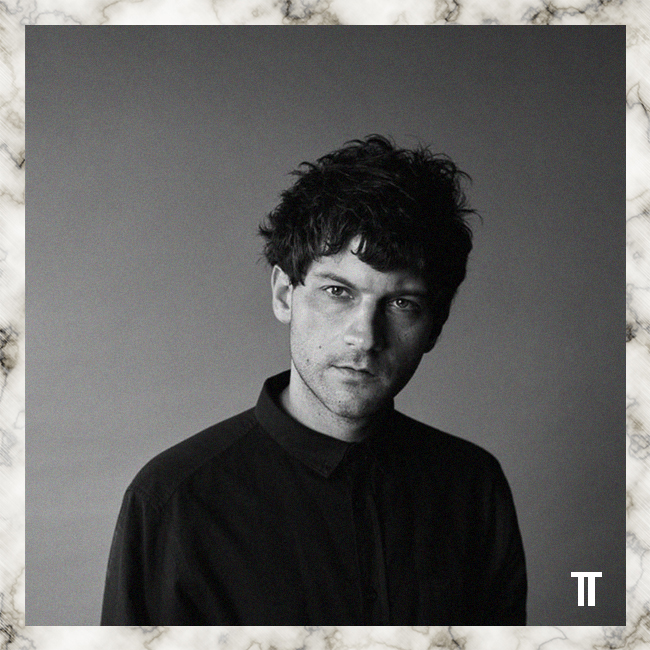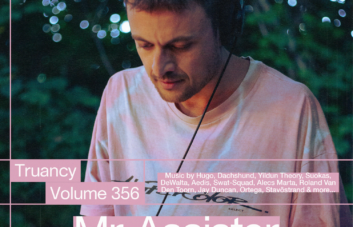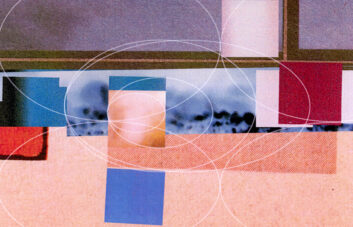Truancy Volume 159 presents a rare mix by the American composer, percussionist and artist Eli Keszler. Perhaps best known for his two acclaimed records on PAN, Cold Pin and Catching Net, Keszler has built up a richly diverse practice within both experimental music scenes and the wider art world. After a brief Google search you may come across a recording of one of his incredibly virtuosic solo drum performances, or perhaps a video of one of his signature piano wire installations strung throughout an exhibition or outdoor spaces. You may even have stumbled across a painting or two in a gallery.
Keszler’s work encompasses scored, graphically notated and improvised music, sound installation and public sonic art. A graduate of the prestigious New England Conservatory of Boston, he sits comfortably within both contemporary classical, experimental, and electronic music worlds. Yet at this centre sits an aesthetic that seems borne from his drumming. Whether its a record, an installation or an ensemble composition, there’s a textural density and intricacy arrived at through a chaotic and unpredictable fashion which echoes the amorphous sound that characterise Keslzer’s solo drum performances. Favouring sustained walls of noise built up from a myriad of individual sounds, Keszler’s percussion ebbs and flows likes waves rather than marking out a perceptible rhythm.
His new album on Last Signs of Speed, is his most stripped back to date, and shows off a more groove-based side to Keszler alongside a plethora of deep, dub-influenced bass. His Truancy Volume certainly reflects this, dominated by jazz and dub, cut, spliced and looped alongside the more surreal side of Keszler’s record collection. We caught up with Eli in his Brooklyn studio ahead of a series of shows at The Yard in London and a short European tour with Dubplates & Mastering deity Rashad Becker.
The first impression of this Truancy Volume I get is that there’s a load of jazz on there. Is this a reflection of your early musical interests, or perhaps what got you into drumming when you were younger? “Yeah, I grew up playing music, but then starting to see people like Elvin Jones and Billy Higgins play live made me realise how deep it is, how far you could go with it. It really transformed me into becoming pretty fanatical about playing and learning, and got me more and more enthused. It’s not just an early interest – I’m still extremely interested… interested isn’t even the word, I just love jazz music and I listen to it all the time.”
What made you pick up drums in the first place? “Well, my Dad is a guitar player and so we would play together quite a bit. I dunno… I’m a very athletic person. I’m moving all the time, and drumming seemed to fit my temperament basically. I played the cello and the piano before drums, but I think that the drums kind of fit me best and I just got into it almost immediately. So. Drums.”
The jazz in the mix seems to be counter-balanced by dub. Is that a passion from an early age as well? I’ve been into Jamaican music since I was very young. My uncle is a really intense collector and used have loads of CDs and records that he’d save for me. In these boxes would be tonnes of reggae, dub, Jamaican R&B, stuff like this, so I’ve been listening to dub since I was 15 or so. I love the space, and on my new record I think I’m attracted to the environment it creates. It treats the recording as a sort of space in itself, as opposed to being a document, or even like a conventional piece of music. It operates more as a ‘space’ which can then be occupied by sounds or textures or rhythms or anything else.
The new record, Last Signs of Speed, is clearly influenced by this dub sound, not least in the presence of more regular, ‘grooved’ rhythms at times. I was about to ask where else in your output the influence of dub may be, but I guess that when you describe dub like you do – as a space – then it’s almost everywhere in your compositions, installations and records. “I think if someone really, really wanted to they could go back through all my records and hear a lot of that in it, actually. But also the way I play the drum is influenced by reggae beats. I use rim shots a lot, but just generally [I] learnt to play that music, plus jazz drumming.
There’s also this sense of space, or the density of it. There’s this scale. If you listen to it, it’s there. On this record I was much more interested in what might happen if I started to experiment with larger amounts of space and push myself into areas that are new in my own work, using very conventional kinds of repetition and seeing what would happen; seeing how far I could push myself in that direction.”
It’s a very stripped back record. “Yeah, really stripped back. I’ve been working on these large scale installations, large scale ensemble pieces, large volumes… everything was big. On this record I was trying to say ‘what if I use the drums and don’t even prepare them? What if I just use bass lines, or just bass pulses? What if I just use a sub to amplify the drums and experiment with building this very sparse atmosphere, or space?’. I think the word space is better. I let it form like that.”
Your installation work is literally about both interior or exterior space, such as your Archway piano-string installation in Brooklyn. How did these pieces come about? “It ties in with what I’ve been saying about the music actually. At a certain point I started to really think about what defined musical experience for me, and how I wanted to think about ‘composing’. So as a composer I learnt about score-writing, giving out parts, that really top down approach. I became more and more interested in defining spaces for music and creating frames for music. That quickly lead to working with spaces and letting music and musicians interact with it in certain ways, letting social interactions play out through that. The installations come from this [idea of] compositional space.”
You’ve touched on your music education as a ‘top down’ composer. I was wondering if you could talk a bit about your time as a student at the New England Conservatory of Boston and how this classical training influences your current work as a composer, performer, and installation artist. “I am definitely a composer; I create things and build music. I feel much more comfortable, fluid and safe in the world of music. Not safe in a bad way, I just mean comfortable, and when I’m outside of that I feel like I’m really pushing myself into more complicated issues that I don’t feel as completely fluid within. Now the great thing is coming back the other way and really pushing music through that more expanded practice.”
I’m really glad I went through a strict, rigorous education because it’s allowed me to apply that in different ways to other fields and disciplines. Also in myself, I’m glad I went to a conservatoire and not to an experimental, whatever, art/sound thing. For me, I really benefitted a lot from the rigour of it but also people not really buying into [my work], or thinking my ideas weren’t focused or something. The kind of conservative aspect of it gives you something to push off of which I think is something that can be an advantage, especially when you’re just starting. You need both support and something to fight against.”
You’ve spoken a lot about space, which ties in with your new piece, Planning Permission. This piece seems more a transcription of spaces rather than a physical occupation of one, although that certainly comes into it as the music is performed within a piano-string installation strung throughout the venue. “Again, filtering the work I’ve done with installations through writing for instrumentalists has been an ongoing project. I’ve become very interested in the differences between the way we hear enclosed, institutional spaces verses public, open spaces. Not necessarily in terms of a field recording research project, but more the conditions of listening for listening and the ways that these spaces effect the way we hear, the way we may put a value on a sound that we hear in a concert hall verses the way we may ignore sounds in public spaces, or the way music carries a certain value in a certain environment than it doesn’t in another.
In this project I’ve taken recordings from public spaces and in a variety of ways filtered them through a concert space, by transcribing these recordings onto actual instruments and also sending these recordings through the architecture of the concert space with parametric speakers and sending the recordings through piano strings that are spread around the space. It’s looking at a way of re contextualising one type of hearing and then performing and experiencing it through another.”
Eli Keszler: Facebook, Soundcloud, Twitter
Catch Eli Keszler playing at the Yard with Paul Mcguire on the 27th and 28th October.
Words by Jack Sheen



